Bert Menco Interview, 2003 by Julie Reichert-Marton
Professor Menco is an artist/biologist, who was for many years employed as Research Associate Professor at Northwestern University, Evanston, IL. He's been making art for over thirty years now.
Bert's work is represented
by Oculus Art + Frame (1900 South Halsted, Chicago, IL 60608, 312-226-3742,
uberdurr@myway.com), the Morpho Gallery (5216 North Damen, Chicago, IL 60625,
773-878-4255, morphogallery@aol.com), and by Michael Greany Fine Art (773-338-2824,
fineartz@rcnchicago.com). Also, see his web page at:
http://www.bertmenco.com.
BM "Thanks for coming over here, Julie."
JRM "I would like you to tell something about your own work. That is your newest piece. Is that a drawing?"
BM "Yes."
JRM "Executed with pencil and colored pencil and very gentle."
BM "I don't know what I am going to call it probably Jester."
JRM "Jester."
BM "I don't know yet...but because of these puppeteers (indicates the figural subject's hands) (eventually the piece has been titled "Pious Jester."
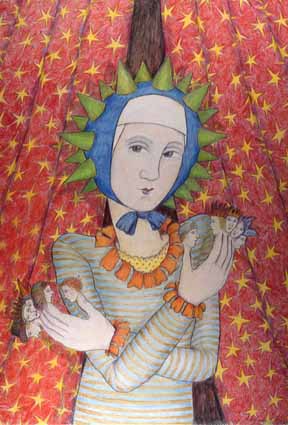
Pious Jester
(pencil/color pencil drawing,
24 x 18 in., 2002) Bert Menco
JRM "The finger puppets?"
BM "They really are her fingers."
JRM "Those are her fingers?"
BM "I think so."
JRM "I am curious, to me many of your pieces look like illustrations from children's fables or fairy tales that are mildly frightening or disturbing. Those are the ones that kids like the most and that stick with us when we become adults. Are these expressions of Dutch children's stories?"
BM "No they are not, at least I do not think so, they are mine."
JRM "They are very imaginative. Do they have an inkling of a narrative story behind them when you are making them?"
BM "They probably do, but I think that the observer can make his or her own narration out of them, using the image as a seed for his/hers imagination, as you do now. For me it is the image that counts."
JRM [Still talking about the same Jester image] "The main figure looks to me like an entertainer or a circus performer, partly dressed in something like a nun's habit."
BM "I think I did this intentionally. It is kind of sensual, perhaps even sexual."
JRM "Did she make her own costume?"
BM "Yes, she being me."
JRM "She has got spikes on her hat. The deception; some kid's stories are not entirely kid's stories, but many have hidden meanings, like the stories of the Grimm Brothers or Mother Goose, but even more contemporary ones like the Wizard of Oz."
BM [Now talking about another image in preparation, a potential etching this time.] "This image started out as a collaborative project, many years ago, with several students at the Evanston Art Center. It should have been an alphabet, each of us responsible for one letter. The plate was neglected, and looked kind of hideous. Now I am challenging myself, reworking it. I have already spent hours and hours on it. And it might still be hideous once I print it, but a challenge is a challenge."
JRM "It is fascinating to see how you draw one layer over the other on the plate."
BM "In this particular case I am trying to include all preexisting imagery of the other people in the new image, a menagerie of strange characters surrounding a potential dark and much larger central figure. Thus really there is one layer over another layer, the former one being a partial. Hence, its title may become "Mutilated Alphabet."
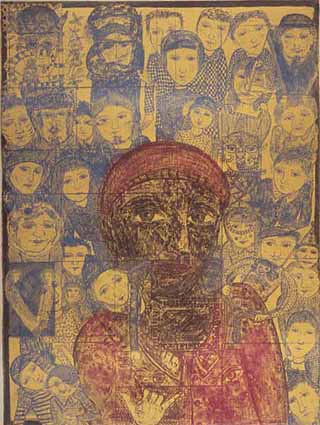
Mutilated Alphabet
(à la poupée
etching/
aquatint, 24 x 19 in., 2003) Bert Menco
JRM "This is called an engraving or an etching?"
BM "Etching, an etching plate is a sheet of metal, zinc or copper covered with an acid/salt-resist. With a needle you draw through the resist, baring the metal so that the acid or salt, usually nitric acid or ferric chloride, can digest the metal away, fixing the drawing in the plate."
BM "(Showing an other drawing). You have seen the one here, called "Soup." It started out as a small sketch that I found among the papers my grandmother had left us. I had made it as a 6 or 7-year-old child. The image intrigued me, and I decided to redo the image with my current, somewhat aging, brain. The result is the larger image."
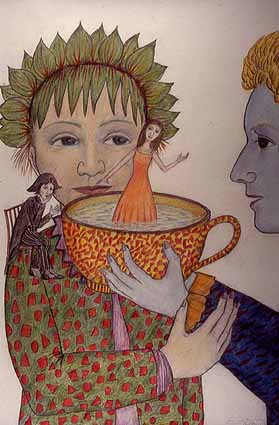
Soup
(pencil/color pencil drawing,
24 x 18 in., 2001)
Bert Menco
JRM "And that is an other drawing executed with pencil and color pencil?"
BM "Yes, called Cats (females, dressed) and Mice (males, naked), the eternal "game" between the sexes. In my drawings I alternate between pencil and color pencil and pen an ink."
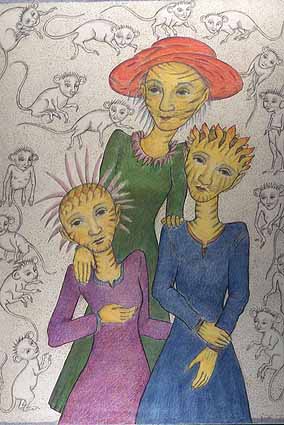
Cats and Mice (pencil/color
drawing,
24 x 18 in., 2001)
Bert Menco
JRM "All those little dots in the background are done by hand? Oh, it looks like different color fibers in the paper. Your image have such a wonderful otherworldly feel to them and are so dreamlike."
BM "They are not
really dreams, not intended to be surreal. They are merely daydreams."
JRM "How do you classify your artwork?"
BM "Poetically narrative, I think. They are not really telling a story, but reflect imaginary situations, feelings, and are really quite personal. I think that some of them appeal deeply to one's emotions, but it is what I have to do, no choice, no alternative, a cry."
JRM "What inspires you? You just get an idea and then you record it?"
BM "I am not exactly sure, but the imagery comes from deep inside me. Then the image generates itself, of course through my hands and my restricted skills. Also, once the idea is there, it is just a lot of hard work to make it into a final product, often taking months."
(Later in our conversation Bert is discussing the downgrading of the printmaking department at the Evanston Art Center, where he has been printing many of his works for about 20 years, amidst a group of eminent other Chicago area artists. Regarding alternatives:)
JRM "What about the Chicago Printmakers‚ Collaborative?"
BM "For practical we relocated to the North Shore Art League in Winnetka, where they really welcomed us."
JRM "They have a printmaking facility?"
BM "Yes, but up to recently perhaps the nicest public facility of the whole North Shore was the one at the Evanston Art Center. It is really a sad scenario that artists are being pushed out of a place like the Evanston Art Center in favor of more community and youth oriented programs. There are so few affordable places where mature artists can do their work, and where artists can work together. Making art is already such a solitary effort. The Evanston Art Center used to be such a nurturing place for us."
JRM "What happened to the printmaking equipment that they had at the EAC?"
BM "It has been moved to the basement of the Noyes Cultural Center. But I gather that there are some obstacles in opening the new studio as no printmaking classes are being given there now, a real sad scenario, that hopefully will be resolved."
JRM "How do you work when you are making your prints? It looks like you prepare the plates here at your home studio and then bring them over to the printmaking facility to print them during class?"
BM "Yes, Julie, all the printing is done during the class."
JRM "Are these classes like a workshop that are self-guided?"
BM "No, there is a teacher, Audrey Niffenegger. Other printmaking faculty includes Rita Price and Jessica Feith. Past faculty at the Art Center were Michael Jackson, Andrew Todd Winship, Caryl Seidenberg, Jeanine Coupe Ryding, Daryl Jenssen, and Holly Greenberg, all excellent artists in their own right."
JRM "Who are the other artists that you worked with in both printmaking facilities?"
BM " At various times, Diane Thodos, Paula Campbell, Sheryl Orlove, Sally Cahill, Marge Roche, Judy Hladek, Paula Buchwald, Karen Perl, Elizabeth Ockwell, Thor Faegre, Susan Flemens, Curtis Bartone, Michael Ferris, Darch Clampitt, and John Rush among many, many others. This image is one of Elizabeth Ockwell."
JRM "This is a print?"
BM "No this is actually a watercolor."
JRM "Oh my goodness."
BM "Yes, I admire her work very much."
JRM "She did this in France?"
BM "Yes, in Versailles, she plans many of her images during travels to various places in Europe."
JRM "How long have you been in Chicago?"
BM "I arrived en 1982."
JRM "When did you discover printmaking?"
BM "In the early seventies. It sounds immodest, but it was really Rembrandt who incited me to learn the fine craft of intaglio printmaking."
BM "Have you seen the work of Michael Ferris, another student in our class? He is a very fine painter coming from a pre-eminent Chicago artists' family, Eleanor and Michael Ferris, Sr. This is Michael, Jr. on this postcard-invite. He recently had a show at the Chicago Cultural Center and, with his family, also one at the Evanston Art Center. Both were beautiful shows. Diane Thodos wrote a very insightful article in CAC's Artist News about the Art Center show."
JRM "Very interesting! Yes, that is a really strong image."
JRM "Where do you show your work?"
BM "Besides (The Athenaeum) I had recent shows at the Elmhurst Art Museum (2001), the Wilmette Public Library (2001), Libreria San Pantalon (a great children bookstore, near the Frari Church) in Venice, Italy (Winter 2002/03), Hyundai Arts Centre Gallery, Ulsan, South Korea (2003), Gallery Mornea in Evanston and at Uncommon Ground in Chicago (both 2003). The last few years I showed work at the Callahan/Walté Studio as part of the Around the Coyote Art Festivals, also in 2003. Upcoming shows are at Studio Arborhenum, Rhenen, The Netherlands (opens October 18, 2003), and the Illinois Institute of Arts, 350 N. Orleans, #136 (opens March 4, 2004). The American Print Alliance has an exhibition that is traveling around the country, and several prints are included in "Reimaging the Multiple", an important show that has been traveling for a few years now and that reopened in Dumfries, Scotland, last Summer (2002) and now at various locations in Spain.
BM "I have several works in Michael Greany's collection. He is a local dealer, who has a splendid collection. I swapped him some of my works for pieces that I liked by miscellaneous artists from his collection. Sometimes I am very attached to my pieces and I don't like to let them go. I let one such drawing go to Michael."
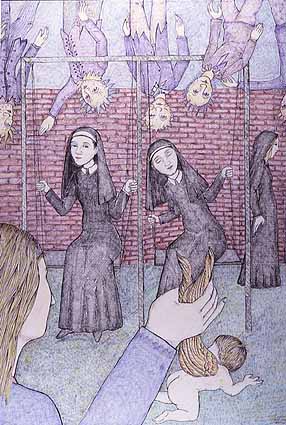
Conception(pen
and ink drawing,
24 x 18 in., 2000)
Bert Menco
JRM "Did you? How interesting."
BM "I felt really awful and missed it for a while, kind of a mini split-up. It slowly subsided, and now I feel very O.K. about this."
JRM "At least you have the peace of mind that the drawing is in very good hands."
BM "Yes, like any other artist and I can't take my works into the grave. It is good to have as many of them "out there" before I am "out there." I really appreciated the opportunity you gave me through this interview, Julie, thanks!"
--The End --